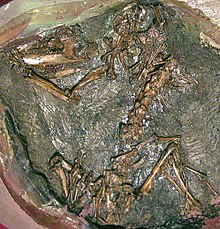Cladotheria
| Cladotheres Temporal range:
| |
|---|---|

| |
| Fossil of the basal cladotherianHenkelotherium guimarotae | |
| Scientific classification | |
| Domain: | Eukaryota |
| Kingdom: | Animalia |
| Phylum: | Chordata |
| Class: | Mammalia |
| Clade: | Trechnotheria |
| Clade: | Cladotheria McKenna, 1975 |
| Subgroups | |
| |
Cladotheriais aclade(sometimes ranked as alegion)[2]ofmammals.It contains moderntherianmammals (marsupialsandplacentals) and severalextinctgroups, such as the "dryolestoids",amphitheriidsandperamurids.The clade was named in 1975 byMalcolm McKenna.In 2002, it was defined as anode-based taxoncontaining "the common ancestor of dryolestids and living therians, plus all its descendants".[1]A different,stem-baseddefinition was given in 2013, in which Cladotheria contains all taxa that are closer toMus musculus(the house mouse) than to the "symmetrodont"Spalacotherium tricuspidens.[3]
Cladotheria incorporates a set of nested mammal clades culminating inTribosphenida(also known as Boreosphenida), mammals with fullytribosphenicteeth such as therians and a few of their closest relatives. The cladePrototribosphenidaincludes "the common ancestor ofVincelestesand living therians, plus all of its descendants ". Apart from tribosphenids, Prototribosphenida also includes amphitheriids and peramurids, as well as a few isolated genera such asVincelestes.It excludes the various basal cladotherian groups which have been combined under the label "dryolestoids".[1]The cladeZatheriais even more exclusive, restricted to solely peramurids and tribosphenids. Zatheria is defined as "the common ancestor ofPeramusand living marsupials and placentals, plus all of its descendants ".[1]
Description
[edit]
Early cladotherians can be distinguished from other mammals by a number of derived traits (apomorphies). Their teeth differed from those of the "symmetrodonts"by the evolution of a talonid shelf (hypoflexid) on the lowermolars,whichoccludedwith theparaconeof the corresponding upper molars. A truetalonid basin,allowing for the crushing and grinding of food, was however absent in early-diverging groups like thedryolestoids,amphitheriidsandperamurids.Cladotherians are also distinguished by a backwards-pointingangular processat the rear end of thedentary bone,below the jaw joint. The shape of this process indicates that early cladotherians had a more transverse (side-to-side) chewing motion than more basal mammal groups. The connection of themiddle ear bonesto the dentary through an ossifiedMeckel's cartilageappears to have been lost in cladotherians, but acartilaginousconnection may have been retained in early-diverging groups.[4]
Phylogeny
[edit]Thecladogrambelow is simplified after a 2022 phylogenetic analysis by Lasseron and colleagues:[5]
| Cladotheria | |
References
[edit]- ^abcdeLuo, Z.-X.; Kielan-Jaworowska, Z.; Cifelli, R. L. (2002)."In quest for a phylogeny of Mesozoic mammals"(PDF).Acta Palaeontologica Polonica.47(1): 1–78.
- ^McKenna, M. C.; Bell, S. K. (1997).Classification of Mammals Above the Species Level.Columbia University Press. pp. 9–10.ISBN978-0-231-11012-9.Retrieved16 March2015.
- ^Averianov, A. O.; Martin, T.; Lopatin, A. V. (2013). "A new phylogeny for basal Trechnotheria and Cladotheria and affinities of South American endemic Late Cretaceous mammals".Naturwissenschaften.100(4): 311–326.Bibcode:2013NW....100..311A.doi:10.1007/s00114-013-1028-3.PMID23494201.S2CID91383652.
- ^Grossnickle, D. M. (2017)."The evolutionary origin of jaw yaw in mammals".Scientific Reports.7(1): 45094.Bibcode:2017NatSR...745094G.doi:10.1038/srep45094.PMC5359619.PMID28322334.
- ^Lasseron, M.; Martin, T.; Allain, R.; Haddoumi, H.; Jalil, N.-E.; Zouhri, S.; Gheerbrant, E. (2022)."An African Radiation of 'Dryolestoidea' (Donodontidae, Cladotheria) and its Significance for Mammalian Evolution"(PDF).Journal of Mammalian Evolution.29(4): 733–761.doi:10.1007/s10914-022-09613-9.S2CID249324444.
External links
[edit]- MESOZOIC MAMMALS; Stem zatherians, zatherians & Peramuridae, an internet directoryArchived2009-10-08 at theWayback Machine
- Palaeos Vertebrates 430_500 Mammalia Spalacotheroidea & Cladotheria





